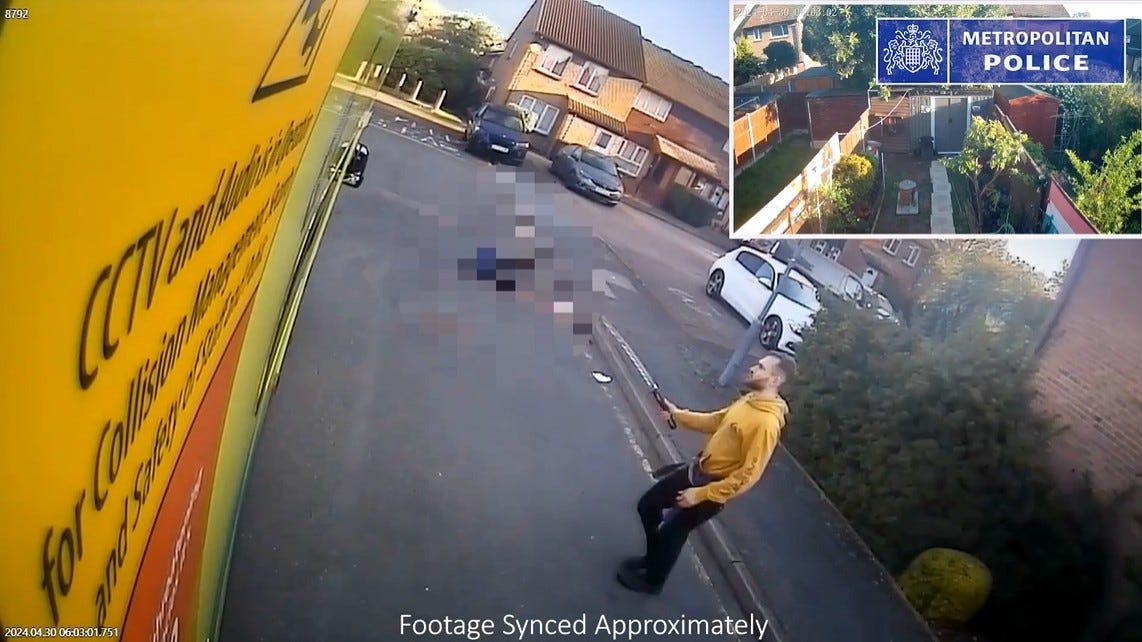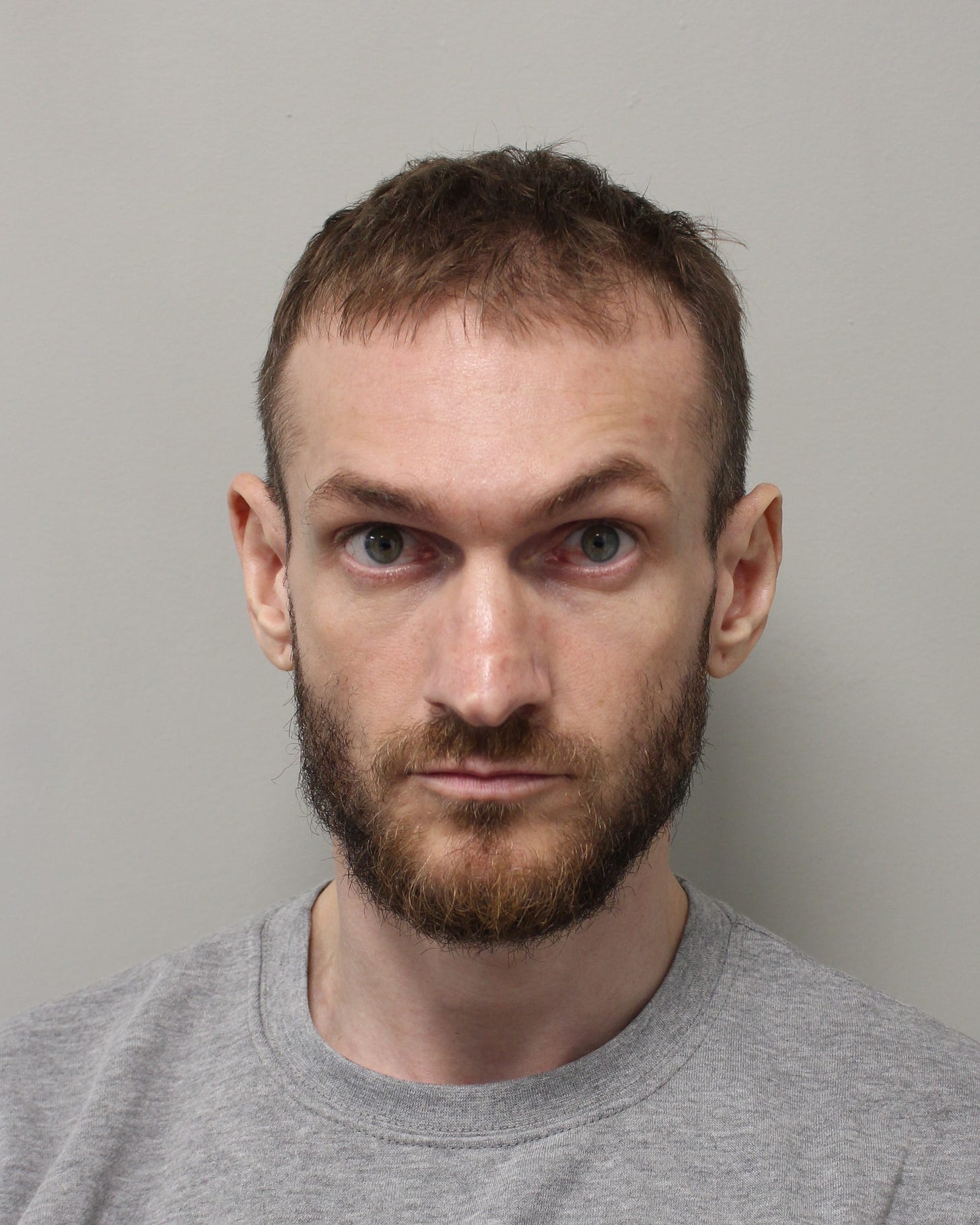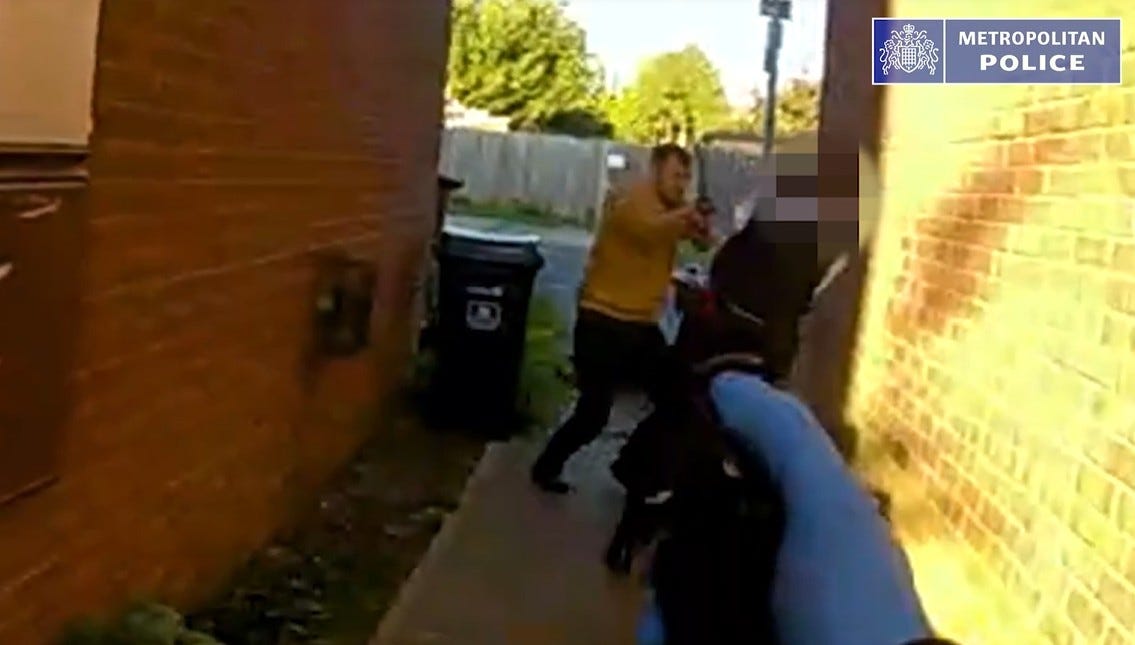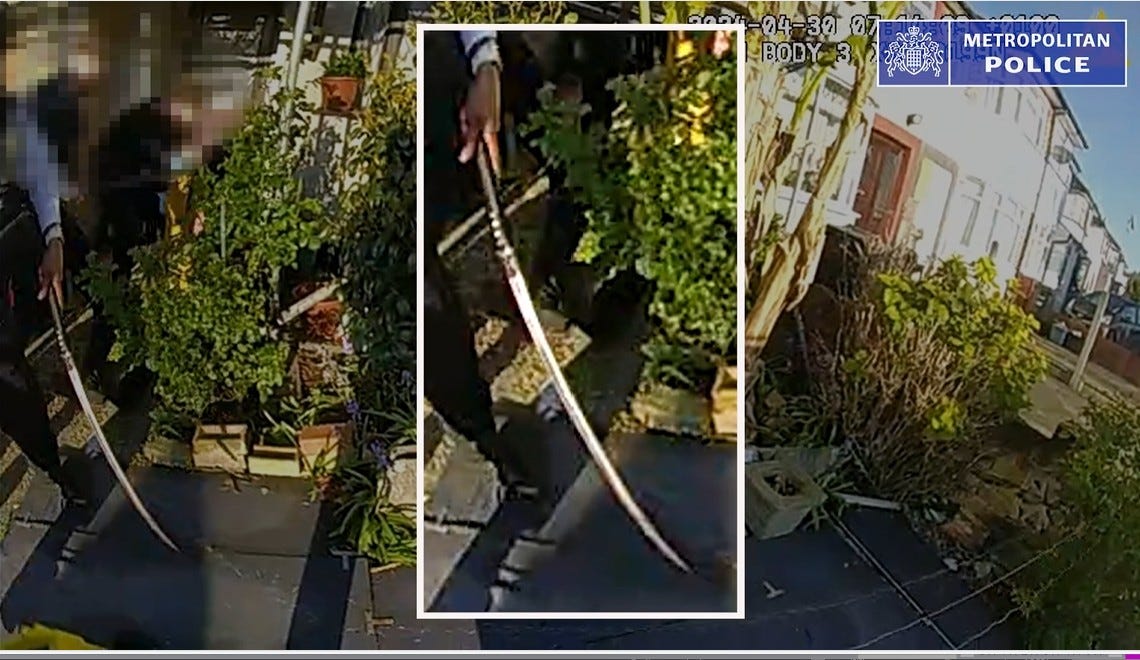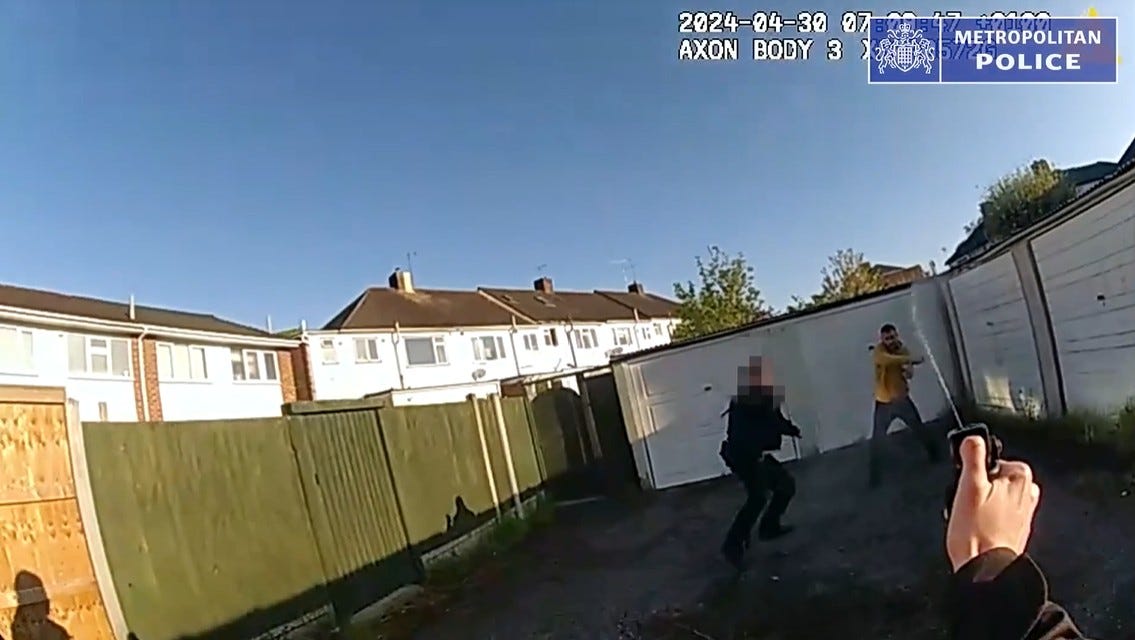When a man armed with a samurai-style sword ran amok one pleasant spring morning in 2024 it naturally became the main story on the rolling news channels.
At the end of his bloody rampage, Marcus Arduini-Monzo, had killed a 14-year-old schoolboy, Daniel Anjorin, and left a community traumatised.
In today’s Substack I will look at why he did it and also run past you a pretty extreme idea - that maybe the Devil was responsible.
Let’s start with the facts.
At 6.30am on 30 April 2024 Arduini-Monzo, 37, left his home in Satanita Close, Beckton, got into his Ford Transit van and drove north - apparently a completely random direction - arriving in Hainault 20 minutes later.
He was wearing a distinctive yellow Quicksilver hoodie, black trousers and black shoes.
His first act was to try and run down Donato Iwule, who was walking from Hainault underground station to his job at a nearby Co-Op store.
Arduini-Monzo and Iwule were complete strangers. In fact he did not know any of his victims and there is little evidence that he had even been to Hainault before.
It was all entirely random, and we will get to what triggered his actions later.
Iwule screamed and jumped out of the way of the van, which knocked over a fence and a concrete pillar.
Arduini-Monzo (pictured below) jumped out of the van and unsheathed his samurai-style sword.
Iwule, no doubt utterly baffled and terrified, shouted: “I don’t know you!”
The swordsman replied: “I don’t care. I will kill you.”
He struck Iwule with the sword, but miraculously his injury was relatively minor and he managed to get away.
Arduini-Monzo got back in his van and drove it down a cul-de-sac, stopping to ring the London Fire Brigade.
He then got out of his van, walked over to a frightened local resident, Aiste Dabasinskatie, with his phone held out and said: “Where are we?”
She ran off, haunted by his demeanour, and escaped with her life.
Aiste called the police on her mobile and hid from Arduini-Monzo, but she then witnessed the most horrific attack of all.
Daniel Anjorin (pictured below) had left home at around 7am and, like millions of teenagers on their way to school, had his headphones on listening to music when he walked right into the path of his killer.
In his opening statement, a copy of which I have obtained, prosecutor Tom Little KC said: “The defendant had obviously seen him and … moved quickly like a predator behind Daniel Anjorin. He lifted the sword above his head and then swung it downwards towards Daniel’s head and neck area.”
He then inexplicably pulled Daniel’s rucksack off his back, dragging the schoolboy’s dead or dying body along the road for a short distance.
By this time the emergency services - ambulance and police - were arriving on the scene and the next few moments were to see some extraordinary bravery by one office in particular.
When they arrived PC Yasmin Mechem-Whitfield and PC Cameron King immediately tried to help Daniel, but as they did Arduini-Monzo approached them and they deployed pepper spray in a bid to keep him back.
He then ran off and they pursued him.
At one point, as they ran down alleys between the houses, PC King warned her: “I cant see him, be careful, he’s got a massive sword.”
Watching the CCTV footage - some of which was released at the conclusion of the trial - it’s difficult not to wish PC Mechem-Whitfield and PC King had guns, like most police officers in such a situation would have in the United States and many other countries.
As PC Mechem-Whitfield, who was in front, got to a certain point Arduini-Monzo jumped out of the bushes and attacked her with the sword.
She tried to deploy her Taser and PC King fired his pepper spray, before the sword fiend ran off again.
Mr Little said: “The defendant must have intended to kill the officer. It is a miracle that he did not do so. She sustained very significant injuries to her head, arms and hand in the line of duty.”
But Arduini-Monzo was not done yet.
He ran into the home of a couple, Sindy Arias and Henry De Los Rios Polania, who were asleep upstairs. They shared their bedroom with their four-year-old daughter.
Suddenly the family found themselves confronted, in their bedroom, with a sword-wielding maniac.
He shouted out: “Do you believe in God?” four times.
Mr De Los Rios Polania held his arm up to protect his wife, and thankfully did not suffer life-threatening injuries when he was struck by the sword.
When the couple’s daughter began crying it distracted Arduini-Monzo, who ran out of the bedroom as suddenly as he had come in, and appeared back out on the street, still shouting at nobody in particular: “Do you believe in God?”
Arduini-Monzo then appeared to be cornered in a garage block by several police officers, but after striking one with the sword, he managed to climb over the garages and into some gardens.
But thankfully he was finally overpowered and arrested a few moments later.
All this before an armed-response vehicle had arrived at the scene.
If armed police had arrived when Arduini-Monzo was still at loose with the sword, there is no doubt he would have been shot dead and there would have been no need for a criminal trial.
But as it was, he denied murder and claimed manslaughter due to diminished responsibility and went on trial at the Old Bailey.
Arduini-Monzo was not denying carrying out the crimes, but his defence counsel, Ian Henderson KC, insisted he had an underlying mental health disorder which led to a psychotic episode.
The prosecution accepted the crimes were committed during a psychotic episode, but said it was triggered by the heavy use of cannabis and that Arduini-Monzo had basically brought it on himself.
In that ways it was very similar to the crimes of Joshua Jacques - who slaughtered four people in a house in Bermondsey, south London, in April 2022 - and Kara Alexander, who drowned her two young sons in the bath in December 2022.
Mr Justice (Joel) Bennathan KC sentenced Kara Alexander, and he was also the judge who sentenced Arduini-Monzo, after a jury had rejected his defence and found him guilty of Daniel’s murder and several other offences stemming from the Hainault incident.
On Friday (27 June) Arduini-Monzo was jailed for life, with a minimum term of 40 years.
In his sentencing remarks, Mr Justice Bennathan said: “I need to consider the state you were in when you committed these offences. You were clearly psychotic.”
He said: “You had traits of a schizotypal disorder that played some part in you becoming psychotic. Your choosing to consume cannabis over the months and days leading up the 30 April last year was the dominant cause of your state that day.”
“You had no reason to believe that cannabis would lead you to commit violent offences, still less the murderous ones of which you have been convicted, but you had some warning of its adverse effect on you: You knew it made you paranoid and could lead at least to panic attacks,” said the judge.
Mr Justice Bennathan said: “The law states, perhaps as a matter of public policy, that the voluntary consumption of drugs cannot found the partial defence of diminished responsibility. The question for me in your case, is whether I can treat your psychotic state caused in large part by the voluntary taking of drugs as mitigation for the offence of murder.”
He added: “In my view the necessary public interest in not letting offenders hide behind drugs they chose to consume is addressed, on the facts of your case, by the consequent rejection of the partial defence of diminished responsibility.”
For the murder, a life sentence is the mandatory term, but the only question for the judge would how long would he set the tariff.
Mr Justice Bennathan said he would ordinary have passed a minimum term of 50 years, but in recognition of Arduini-Monzo’s “mental ill health and previous good character” he reduced it to 40 years.
Considering time served on remand, Arduini-Monzo will not be released before his 76th birthday.
One final thought - I have covered an awful lot of cases where juries have been asked to consider whether it was “murder” or “manslaughter by diminished responsibility.”
Journalists, and I suspect lawyers, sometimes call it the “mad or bad” question.
But is there a third possibility?
Rather than being just bad, could Arduini-Monzo have been evil?
In other words, could he have been possessed by the Devil, Satan, Lucifer, Beelzebub, whatever you want to call him?
I’m a generally pretty agnostic guy, but cases like this do often have me wondering whether there are “forces of evil” out there.
In Arduini-Monzo’s case it seemed very odd that his address was in Satanita Close. SATANita Close.
Is that Satan’s idea of a joke?
Satanita by the way, was a yacht which collided with another boat in 1897, leading to a famous civil case which set a legal precedent.
There is also, bizarrely, a company called Satanita Limited. For a moment I thought I might find listed under the directors, Louis Cyphre*.
Secondly, there’s that refrain which Arduini-Monzo used throughout: “Do you believe in God?”
Was that the Devil testing the victims’ and witnesses’ faith in God?
Often, people whose loved ones are murdered in circumstances which make no sense find themselves wondering: “How could God have let this happen?”
His father, Dr Ebenezer Anjorin, made a point of thanking their church in their victim impact statement and said: “We honour Daniel’s memory, not in the shadow of this tragedy but through the love and happiness that he brought to us and all those who knew him.”
Maybe incidents like the Hainault rampage are moments when the Devil has the occasional victory over God.
Talk it over with your vicar, priest, imam or rabbi.
* In the classic 1987 movie Angel Heart, Robert De Niro’s character Louis Cyphre is revealed at the end to be Satan himself.




